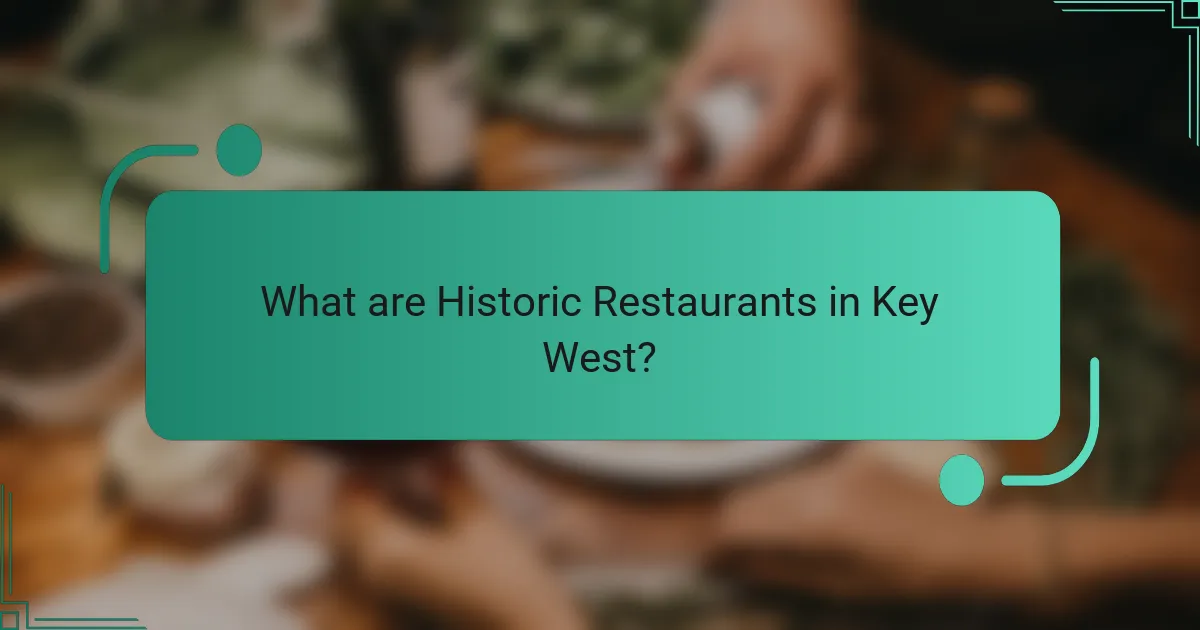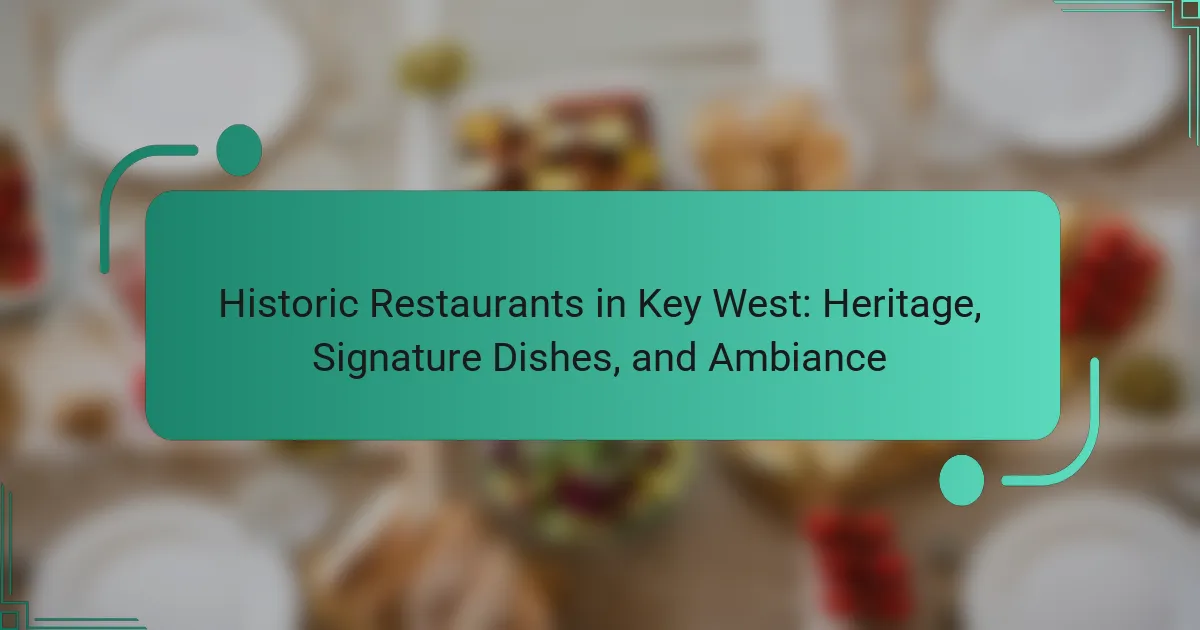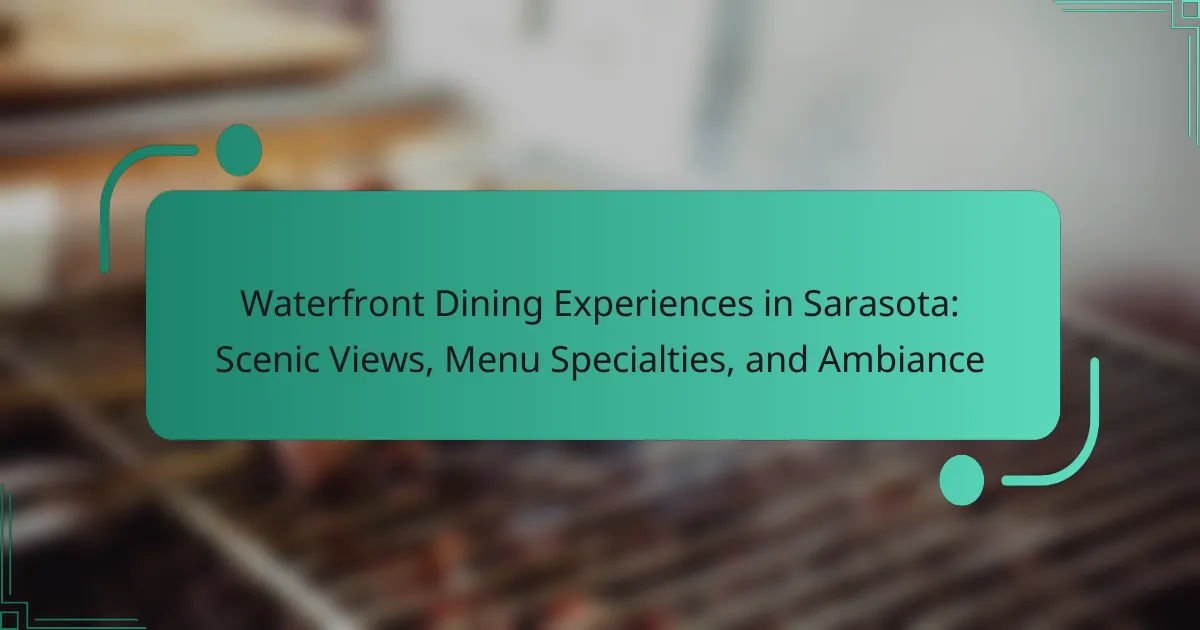Historic restaurants in Key West are dining establishments that hold significant historical value and showcase the island’s cultural heritage through their architecture and decor. Notable examples include Sloppy Joe’s, established in 1933 and linked to author Ernest Hemingway, and the Old Town Tavern, dating back to the 1800s. These restaurants not only serve traditional cuisine but also offer insights into Key West’s rich history. Their enduring presence enhances the area’s charm and allure, making them essential destinations for both locals and visitors.

What are Historic Restaurants in Key West?
Historic restaurants in Key West are dining establishments with significant historical value. These restaurants often feature architecture and decor that reflect the island’s unique heritage. Examples include the famous Sloppy Joe’s, established in 1933, known for its connection to author Ernest Hemingway. Another notable restaurant is the Old Town Tavern, which dates back to the 1800s. These venues not only offer traditional cuisine but also provide insights into the cultural history of Key West. Their enduring presence contributes to the charm and allure of the area.
How do Historic Restaurants in Key West reflect the local culture?
Historic restaurants in Key West reflect the local culture through their unique architecture, traditional cuisine, and historical significance. Many of these establishments are housed in buildings that date back to the 19th century, showcasing the island’s colonial and maritime heritage. The menus often feature local seafood and dishes influenced by Caribbean, Cuban, and Southern cuisines, highlighting the multicultural background of the area. For example, dishes like conch fritters and key lime pie are staples that represent the local culinary identity. Additionally, these restaurants often serve as gathering places for the community, fostering social interaction and cultural exchange. Their decor frequently includes artifacts and memorabilia that tell the story of Key West’s past, further connecting diners to the island’s rich history. Overall, historic restaurants serve as cultural landmarks that preserve and promote Key West’s unique heritage.
What historical events influenced the establishment of these restaurants?
The establishment of historic restaurants in Key West was influenced by several key historical events. The arrival of Spanish settlers in the 16th century introduced new culinary traditions. The establishment of the cigar industry in the 19th century attracted workers and contributed to the local dining scene. The construction of the Overseas Railroad in the early 20th century boosted tourism and increased demand for dining options. Additionally, the Prohibition era in the 1920s led to the rise of speakeasies and hidden bars, shaping the restaurant landscape. These events collectively created a unique culinary heritage that defines Key West’s historic restaurants today.
How do the architectural styles of these restaurants represent Key West’s heritage?
The architectural styles of restaurants in Key West reflect the island’s diverse cultural heritage. Many structures showcase Victorian and Caribbean influences. The use of vibrant colors and wooden verandas is prevalent. These features highlight the island’s historical ties to maritime trade. The conch-style architecture is distinctive to the region. It represents the influence of Bahamian settlers. Architectural details often include louvered shutters and tin roofs. These elements are designed to withstand tropical weather while enhancing aesthetics. Collectively, these styles narrate Key West’s rich history and cultural evolution.
Why are Signature Dishes important to Historic Restaurants in Key West?
Signature dishes are crucial to historic restaurants in Key West because they embody the culinary heritage of the region. These dishes often reflect local ingredients and traditional cooking methods. They create a unique dining experience that attracts both tourists and locals. Signature dishes also enhance the restaurant’s identity and brand recognition. For example, a restaurant known for its conch fritters may draw visitors specifically seeking that experience. Additionally, these dishes often carry historical significance, connecting diners to the culture and stories of Key West. By preserving these culinary traditions, historic restaurants contribute to the community’s cultural landscape. Overall, signature dishes serve as a bridge between the past and present, enriching the dining experience in Key West.
What are some iconic dishes that define Key West’s culinary scene?
Key West’s culinary scene is defined by several iconic dishes. Key lime pie is a standout dessert made from Key limes, sweetened condensed milk, and a graham cracker crust. Conch fritters are another local favorite, featuring conch meat mixed with batter and fried until golden. Fresh seafood, particularly stone crab claws, is a staple, served with a mustard dipping sauce. The Cuban sandwich, a blend of ham, roast pork, Swiss cheese, pickles, and mustard, reflects the area’s rich cultural influences. Additionally, the fish sandwich, often made with snapper or mahi-mahi, is popular among locals and tourists alike. Each dish showcases the unique flavors and culinary heritage of Key West.
How do local ingredients contribute to the uniqueness of these dishes?
Local ingredients significantly enhance the uniqueness of dishes in Key West. They reflect the region’s culture, history, and environment. Fresh seafood from the surrounding waters is a prime example. Key West is known for its conch, which adds a distinct flavor to local recipes. Tropical fruits like mangoes and key limes also contribute unique tastes. These ingredients often have historical significance tied to the area’s culinary traditions. For instance, the use of spices and herbs from local gardens showcases the influence of various cultures. The combination of these elements creates dishes that are not only flavorful but also tell a story of the region’s heritage. This connection to local ingredients makes each dish a representation of Key West’s identity.
What role does Ambiance play in the experience of dining at Historic Restaurants?
Ambiance significantly enhances the dining experience at historic restaurants. It creates a unique atmosphere that reflects the restaurant’s history and cultural significance. Elements such as decor, lighting, and music contribute to this ambiance. For example, antique furnishings can evoke nostalgia and transport diners to a different era. The ambiance also influences diners’ emotional responses, making meals more memorable. Research shows that a well-crafted ambiance can increase customer satisfaction and encourage repeat visits. Historic restaurants often use their ambiance to differentiate themselves in a competitive market. This strategic use of ambiance helps to attract tourists and locals alike, reinforcing the restaurant’s identity and heritage.
How does the decor of these restaurants enhance the dining experience?
The decor of historic restaurants in Key West enhances the dining experience by creating a unique atmosphere. This ambiance reflects the local culture and history, immersing diners in the environment. Elements like vintage furnishings and nautical themes evoke a sense of place. The decor often features local art, which connects diners to the community. Lighting plays a crucial role, setting the mood for a relaxed dining experience. Color schemes can influence emotions, making meals more enjoyable. The overall aesthetic can stimulate appetite and enhance social interactions. Historical elements in decor can spark conversations about the restaurant’s heritage.
What atmosphere do diners typically expect at Historic Restaurants in Key West?
Diners typically expect a vibrant and relaxed atmosphere at Historic Restaurants in Key West. These establishments often feature a blend of traditional decor and local art. Outdoor seating is common, allowing guests to enjoy the tropical climate. Many historic restaurants showcase their rich history through unique architectural elements. Live music often enhances the dining experience, contributing to the lively ambiance. Diners appreciate the warm hospitality and friendly service that characterize these venues. The overall atmosphere reflects the laid-back charm of Key West, making it inviting for both locals and tourists.
How do Historic Restaurants in Key West maintain their legacy?
Historic restaurants in Key West maintain their legacy through a combination of preserving traditions, offering signature dishes, and fostering community connections. They often retain original recipes that reflect local culture and history. Many have been in operation for decades, creating a sense of continuity. These establishments frequently showcase their historical significance through decor and storytelling. They also engage with the community by hosting events and supporting local artists. Additionally, some historic restaurants are recognized as landmarks, enhancing their status and attracting tourists. This blend of culinary heritage and community involvement solidifies their lasting presence in Key West.
What challenges do these restaurants face in preserving their heritage?
Historic restaurants in Key West face several challenges in preserving their heritage. One major challenge is the pressure to modernize menus to attract a broader customer base. This often leads to the dilution of traditional recipes and cooking methods. Additionally, rising operational costs can force these establishments to compromise on quality ingredients that reflect their heritage.
Another challenge is the competition from new dining establishments that may offer trendy concepts. This can overshadow the unique cultural significance of historic restaurants. Furthermore, changing demographics and tourist preferences can lead to a decline in patronage for traditional dining experiences.
Lastly, the need for renovations to comply with safety regulations can alter the original ambiance and architecture that are integral to a restaurant’s heritage. These factors collectively threaten the authenticity and cultural legacy of historic restaurants in Key West.
What tips can enhance your visit to Historic Restaurants in Key West?
To enhance your visit to historic restaurants in Key West, consider making reservations in advance. Many popular spots can fill up quickly, especially during peak tourist seasons. Arriving early allows you to enjoy the ambiance without the rush. Familiarize yourself with the restaurant’s history to appreciate its significance. Asking staff about signature dishes can lead to a memorable dining experience. Pairing your meal with local wines or cocktails enhances the flavors of the dishes. Lastly, take time to explore the surrounding area after your meal, as many historic restaurants are near other attractions.
Historic restaurants in Key West are dining establishments with significant historical value, showcasing the island’s unique heritage through architecture, traditional cuisine, and cultural significance. The article explores how these venues reflect local culture, the historical events that influenced their establishment, and the iconic dishes that define Key West’s culinary scene. It also examines the role of ambiance and decor in enhancing the dining experience, the challenges these restaurants face in preserving their heritage, and tips for visitors to maximize their experience. Overall, historic restaurants serve as cultural landmarks that preserve and promote Key West’s rich history and culinary identity.



